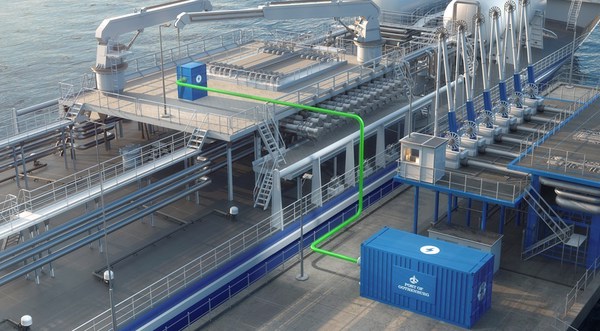Gothenburg looks to roll out world's first shore power system for tankers
Sweden's Port of Gothenburg has set out to develop a global standard to safely connect berthed tankers to shore power at terminals.
 PHOTO: Model of a green pipe housing a power cable that connects a blue shore power supply point to a receiving blue point at the centre of a tanker. Gothenburg Port Authority
PHOTO: Model of a green pipe housing a power cable that connects a blue shore power supply point to a receiving blue point at the centre of a tanker. Gothenburg Port Authority
These tanker terminals are typically designated as “hazardous environments” due to the high risk of igniting a fire.
Sparks from electrical shore power equipment and gases emitted from highly flammable oil products can be a dangerous combination and has so far meant that supplying shore power to tankers is risky. These constant risks have been the main challenge to overcome, says production engineer Jörgen Wrennfors at the Gothenburg Port Authority Energy Terminal.
Classification society guidelines specify that power supply points should be located at the aft of tankers. Wrennfors argues that lifting power connector cables to the aft would require ports to build connecting cranes at the quayside. Because vessels can vary greatly in size this if often expensive and complicated.
To overcome this challenge the Port of Gothenburg is proposing to move the power supply points to the centre of tankers and is working with shipbuilders to adopt this in future vessel designs.
“As all tankers have their loading crane in the center of the vessel this would be the optimal solution for lifting the power cable on board and the length of the vessel would no longer be an issue and the direction in which she docks is irrelevant,” says Wrennfors.
But only placing these connection points at the centre of tankers does not guarantee safety from fire, Port of Gothenburg says. This can be resolved by working with overpressure in the spaces where the cable is housed and connected, thus securing the facility by shutting out any combustible gases, says Wrennfors.
He suggests this technology can be adopted by major ports, companies, public authorities and classification societies.
The Port of Gothenburg aims to connect shore power to tanker vessels at its Energy Terminal in the next two years and has partnered with different stakeholders including a classification society, shipping and oil companies.
It says the Swedish shipping companies Furutank, Donsötank, Tärntank, Ektank, Veritas Tanker and Tarbit Tanker have all ordered vessels that can use this shore power system. The first vessel to be fully shore power-ready was delivered in February this year.
Earlier this year, Sweden's Port of Kapellskär near Stockholm announced its plan to connect Finnlines ferries to shore power by next year. Shore power has been more common in port areas receiving ferries.
Gothenburg claims shore power supply to tankers can reduce carbon dioxide emissions in the port by 1,815 mt/year as vessels can turn their diesel engines off during loading and discharging.





